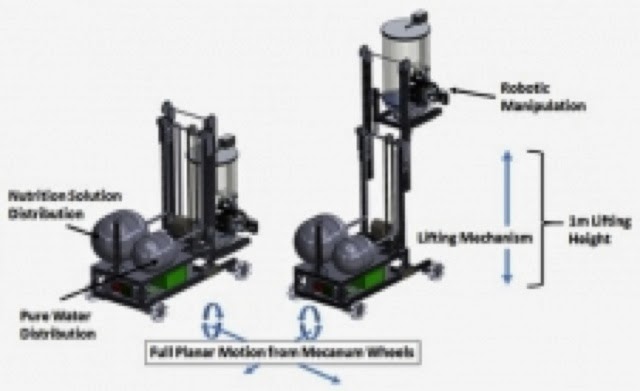Colorado University – Remotely Operated Gardening Robot System
Oklahoma State University – Vertical Habitat Design
Rice University – SpaceRing Power-Cooling System
University of Maryland – Neutral Buoyancy Habitat Study
University of South Alabama – Novel Absorbent Air Revitalization for Closed Environments
University of Wisconsin – Compartmentalized Onboard Material Extrusion Technology
Colorado University has the Remote Operated Gardening Robot System, something that could certainly find use here on Earth as well. The need for a robotic gardener comes from the simpler fact that both food and air are necessary for the sustenance of life no matter where you are. Between the remotely operated gardening robot (or ROGR) and their Smart Pot System (SPOT) the astronauts food supply can be autonomously or remotely tended to. This is optimal for either a long mission in deep space or on a planet where perhaps the greenhouses need to be located a ways from the main habitat.
Oklahoma State University has taken the Vertical Habitat Design option for a habitat and has the ability to attach or expand an airlock on its side and is for up to three crew members. Their vertical design is for work, sleep, storage and the proposed design has two levels with a total square footage of 300.
University of Maryland’s area is a different angle on the habitats utilizing a neutral buoyancy facility at the school and testing their habitat systems for various orientations. One of their primary goals is to decide if vertical or horizontal habitats are more effective. This will of course be taking into consideration what systems are able to operate with zero, partial, or equivalent to Earth gravitational forces. They will be able to offer data to support which system in which environment and giving not only recommendations but also noting potential issues.
South Alabama has been tasked with Novel Absorbent Air Revitalization for Closed Environments. What that means in simple speak is an air cleanser. The system is compact in its design and uses a molecular framework absorbent-based system. When complete it will efficiently break down any Carbon Monoxide and create breathable air as well as monitoring environmental air conditions.
The last category goes to University of Wisconsin, but don’t make the mistake of thinking it is any less crucial. Suppose the crew is six months out from Earth and some part breaks that are essential. Can’t turn back, even if they could the loss of this part might interfere with steering or some other main function. The University of Wisconsin is working to provide a collapsible 3D printer. The astronauts could never plan for every emergency; know which particular part might break down, and with a 3D printer, and with this single item, they won’t have to. This could literally save the mission, their lives, overall weight hence cost, and so on.
**All of this I find totally fascinating. College wasn’t this cool when I went! I am glad that yes they have obviously learned the basics of the different sciences but they are now in the area that needs the type of thinking that takes the book stuff and merges it with the out of the box answers. I also think it is great that NASA challenges them. After all, some of them may be our future astronauts or colonists on the Moon, Mars, etc….










No comments:
Post a Comment